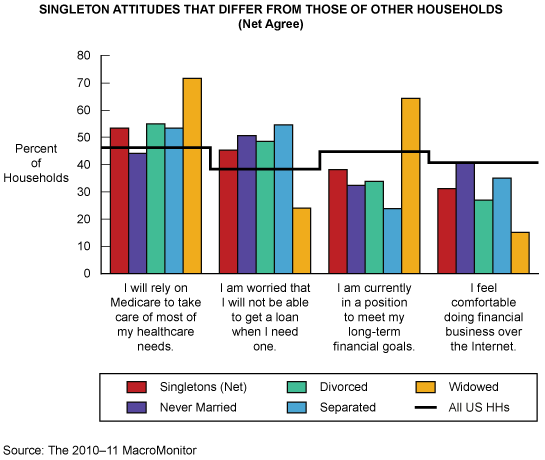MacroMonitor Market Trends April 2012
MacroMonitor Market Trends is a newsletter from Consumer Financial Decisions that highlights topical news and trends of interest to you and your colleagues. If you would like more information about the topic in the newsletter or would like to discuss other ways that we can assist you in your research and marketing efforts, please contact us.
Singletons: 50 Million Single-Headed Households
The decline of the traditional nuclear family results in an increase in the number of multigenerational and single-headed households. Single-headed households are households headed by an individual who is single (never married), divorced, legally separated, or widowed. Single-headed—Singleton—households now represent nearly 50 million of roughly 125 million independent US economic households.
Singletons share many demographic, balance-sheet, and attitudinal characteristics with all US households. Expectedly, Singletons' household incomes are lower than those of dual-earner households. Singletons are less likely than other households to have children but are more likely to be financially responsible for other adults. Even with a high proportion of young adults in their ranks, Singletons' average age is slightly older than the age for all other households: age 53, in comparison with age 50. Overall, their level of education matches that for all US households. Interestingly, Singletons are just as likely to own most types of assets, both tangible and financial, as are all other households, although their balances tend to be lower.
For investing, Singletons are as likely as all households to want the highest return for the lowest risk. In fact, regardless of whether the most important factor for saving and investing is safety, current income, capital gains, or liquidity, Singletons mirror the general public in the proportion who select each. Similarly, Singletons are just as likely as other households to want to do business with a single financial provider and to resist variable rates when borrowing.
To meet Singletons' financial needs, one would be mistaken to lump all these households together; differences depend on their status. For example, even though all Singletons are less likely than other households to have dependent children, separated household heads are more likely to have both dependent children and Boomerang kids (children who have left home, only to return). Divorced and widowed household heads are more likely to have financial responsibility for another adult. And even though Singletons' financial balances are generally lower than balances for other households, widowed-households' balances are significantly higher than for all households.

Except never-married household heads, most Singletons are reliant on Medicare or Medicaid for health care; widows are the most dependent. Widowed heads also differ in that they are less likely than other Singleton groups to worry about their ability to secure a loan should they need one. The majority of Singletons are not in a position to meet their long-term goals. In part because of their age, the majority of Singletons—except never-married households—are less comfortable doing financial business over the internet than are all US households. Singletons look for convenience, easy access, and product and service bundles not advantaged by the economic efficiency of a dual-headed household.
MacroMonitor sponsors may access a more in-depth Singletons Segment Summary on our website.
To learn more about Singletons and your institution, contact CFD.